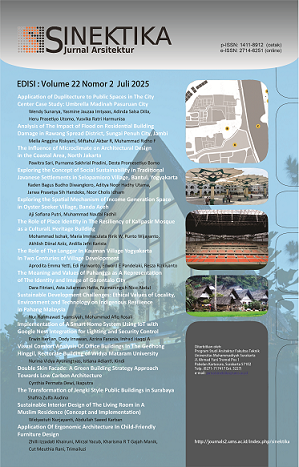The Role of Place Identity in The Resiliency of Kalipasir Mosque as a Cultural Heritage Building
DOI:
https://doi.org/10.23917/sinektika.v22i2.7287Keywords:
Cultural Heritage, Mosque, Place Identity, Resilience, Settlement, TourismAbstract
The existence of Kalipasir Mosque as a Cultural Heritage building is one of the character-defining elements of the Pasar Lama Cultural Heritage area in Tangerang, Banten. Currently, Kalipasir Mosque is situated in the middle of a densely populated settlement and has become one of the tourist destinations in the Pasar Lama area. A prominent characteristic of the settlement's growth around the mosque is the large number of migrants who have moved and settled there, primarily due to the convenient and easy access to Tangerang city center. This phenomenon leads to a research question: Can the Kalipasir Mosque building sustain itself as a cultural heritage site amidst the changing characteristics of its surrounding settlements? A descriptive-analytical research method is employed to examine the place-making that occurs in the spaces around the mosque, shaped by the activities carried out by residents living in the adjacent settlement. Data exploration was conducted through interviews and data collection via questionnaires distributed to residents and worshippers around the mosque. The results of this research show that place identity plays a crucial role in the resilience of Kalipasir Mosque as a Cultural Heritage building. This place identity is shaped by several factors: the designation of Kalipasir Mosque as a Cultural Heritage building, the occurrence of religious and educational tourism, and the resulting pride felt by residents in the surrounding settlements.
Downloads
References
Abdel-Hady, Z. (2010). The Masjid, Yesterday and Today. Center for International and Regional Studies.hdl.handle.net/10822/559277
Aryanti, T. (2007). The Center vs. The Periphery In Central- Javanese Mosque Architecture. Dimensi: Journal of Architecture and Built Environment, 34(2), pp. 73–80. https://doi.org/10.9744/dimensi.34.2.pp. 73-80
Bernardo, F., & Palma-Oliveira, J.-M. (2016). Urban Neighbourhoods and Intergroup Relations: The Importance of Place Identity. Journal of Environmental Psychology, 45, 239–251. https://doi.org/https://doi.org/10.1016/j.jenvp.2016.01.010
Fitri, M., & Triyadi, S. (2015). Community Cultures in Creating the Place-Bound Identity in Musi Riparian, Palembang. Procedia - Social and Behavioral Sciences, 184, 394–400. https://doi.org/https://doi.org/10.1016/j.sbspro.2015.05.108
Ischak, M., Setioko, B., & Gandarum, D. N. (2018). Peran Place Identity Dalam Menciptakan Community Resiliance Di Wilayah Urban Fringe. Jurnal Arsitektur Zonasi, 1(2), 77-86. doi:http://dx.doi.org/10.17509/jaz.v1i2.12254
Ismail, A. S. (2018). Representation of National Identity in Malaysian State Mosque Built Form as a Socio- cultural Product. International Journal of Built Environment and Sustainability, 5(1). https://doi.org/10.11113/ijbes.v5.n1.243
Manenti, C. (2011). Sustainability and place identity. Procedia Engineering, 21, 1104-1109. doi:10.1016/j.proeng.2011.11.2117
Mateo, M. P. (2019). The Mosque as an Educational Space: Muslim Women and Religious Authority in 21st-Century Spain. Religions, 10(3), 222. https://doi.org/10.3390/rel10030222
Nata, A. (2021). Peran dan fungsi masjid di Indonesia dalam perspektif pendidikan Islam, Ta'dibuna: Jurnal Pendidikan Islam, 10(3): 414-432. doi:http://dx.doi.org/10.32832/tadibuna.v10i3.5203
Naylor, S., & Ryan, J. R. (2002). The mosque in the suburbs: Negotiating religion and ethnicity in South London. Social & Cultural Geography, 3(1), 39–59. https://doi.org/10.1080/14649360120114134
Nyhagen, L. (2019). Mosques as Gendered Spaces: The Complexity of Women’s Compliance with, And Resistance to, Dominant Gender Norms, And the Importance of Male Allies. Religions, 10(5), 321. https://doi.org/10.3390/rel10050321
Pratt, A. C. (2015). Resilience, locality and the cultural economy. City, Culture and Society, 6(3), 61–67. https://doi.org/https://doi.org/10.1016/j.ccs.2014.11.001
Qazimi, S. (2014). Sense of Place and Place Identity. European Journal of Social Sciences Education and Research, 1(1), 306-310. doi:10.26417/ejser.v1i1.p306-310
Rifa’i, A. (2016). Revitalisasi Fungsi Masjid Dalam Kehidupan Masyarakat Modern. Universum, 10(02),155–163. https://doi.org/10.30762/universum.v10i02.758
Rosalina, P. D., Dupre, K., & Wang, Y. (2021). Rural tourism: A systematic literature review on definitions and challenges. Journal of Hospitality and Tourism Management, 47, 134–149. https://doi.org/https://doi.org/10.1016/j.jhtm.2021.03.001
Sagala, S., Anwar, H., Lubis, W., & Yamin, D. (2015). Strengthening Community Resilience from Spatial Plan Perspective. Masyarakat Tangguh Bencana, Pendekatan Sosial Ekonomi, LIPI: Tata Kelola dan Tata Ruang
Satwiko, F., Winandari, M. I. ririk, & Iskandar, J. (2023). Mosque Typology in Indonesia Based on Vernacular Architecture. Sinektika Jurnal Arsitektur, 20(1), 48–55
Shamsid-Deen, M. D. (2016). Breaking Ground: The Phoenix Mosque and Institute Project as a Template for Mosque Transformation and Development in America. J. Islam. Stud. Cult., 4, 12-21.
Sutarjo, B., Darjosanjoto, E. T. S., & Faqih, M. (2019). Changes in the Form, Space, and Meaning of Community Mosque Architecture in Surabaya, Indonesia. Int. J. Eng. Sci.||, 8, 23-42.
Targowski, W., & Piotr, C. (2017, October). Shaping Place Identity through Interaction on the Example of the European Solidarity Centre in Gdansk. In IOP Conference Series: Materials Science and Engineering (Vol. 245, No. 4, p. 042055). IOP Publishing. doi:10.1088/1757-899X/245/4/042055
Thulstrup, A. W. (2015). Livelihood Resilience and Adaptive Capacity: Tracing Changes in Household Access to Capital in Central Vietnam. World Development, 74, 352–362. https://doi.org/https://doi.org/10.1016/j.worlddev.2015.05.019
Tangerang City Government. (2023). Tangerang Mayor Regulation No. 111 of 2023 concerning the detailed spatial plan of Tangerang City 2023–2045. Tangerang City Government.
Ujang, N. (2012). Place attachment and continuity of urban place identity. Procedia-Social and Behavioral /
Sciences, 49, 156-167.
Wilson, G. A. (2012). Community resilience, globalization, and transitional pathways of decision-making. Geoforum, 43(6), 1218–1231. https://doi.org/https://doi.org/10.1016/j.geoforum.2012.03.008
Winandari, M. I. R., Setiadi, V. S., Wijayanto, P., Hartono, E. E., Rahmad, D. A. (2025). Empowering the Kalipasir Cultural Heritage Community Through Digital-Based Potential Optimization. Jurnal AKAL: Abdimas dan Kearifan Lokal, 6(1), 144-154. https://doi.org/10.25105/akal.v6i1.21400
Downloads
Submitted
Accepted
Published
Issue
Section
License
Copyright (c) 2025 Sinektika: Jurnal Arsitektur

This work is licensed under a Creative Commons Attribution-NonCommercial 4.0 International License.











